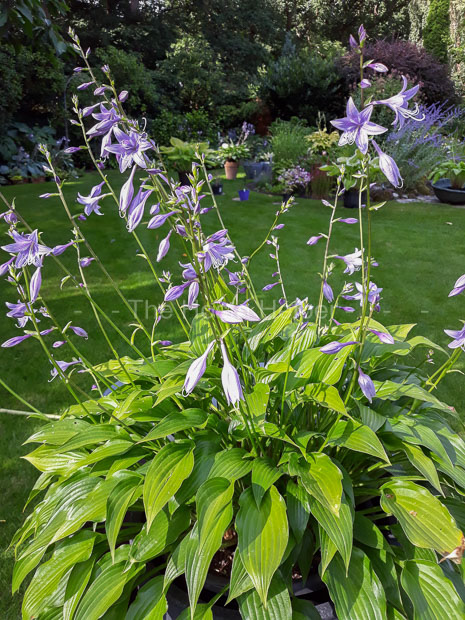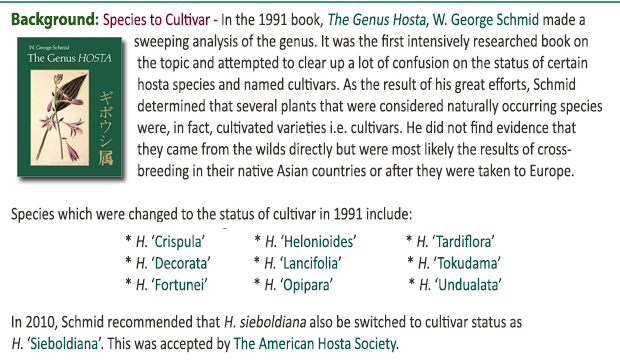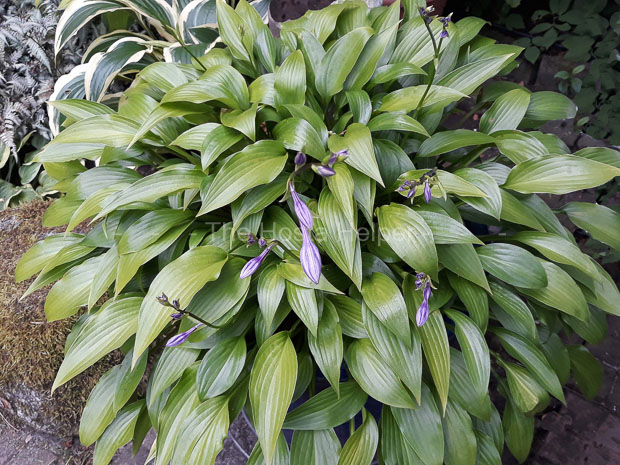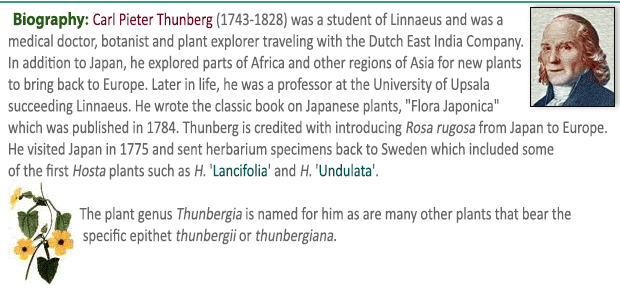|
 Historically called the "Narrow-leaved Plantainlily",
H. 'Lancifolia' Is one of the most
widely grown of all the hostas. It was originally introduced
into the United States from China in the late 1800's. Historically called the "Narrow-leaved Plantainlily",
H. 'Lancifolia' Is one of the most
widely grown of all the hostas. It was originally introduced
into the United States from China in the late 1800's.
It forms a medium size (16
inches high by 36 inches wide) mound of lance shaped, smooth textured foliage with
thin substance. The flowers are medium lavender and bloom on
numerous scapes from mid-August into September.

According to
The Hostapedia by Mark Zilis (2009), "...has many desirable
characteristics, including a fast growth rate, a symmetrical
mound habit, decent foliage, and a good late-season show of
flowers. For those very reasons, however, it has been vastly
overused during the last one-hundred years. There are now
thousands of hostas with better substance, more exciting
foliage, and better flowers so most hosta collectors ignore this
workhorse of the shade garden."
 This plant has been awarded the
Royal Horticultural Society's Award of Garden Merit in the
UK. It may have been sold in the past as Mackwoods No.
16. This plant has been awarded the
Royal Horticultural Society's Award of Garden Merit in the
UK. It may have been sold in the past as Mackwoods No.
16.
The New Encyclopedia of Hostas by
Diana
Grenfell (2009) states: "...often confused with
H.
cathayana and
H.
sieboldii... Emerges early, so the leaves may
be damaged by spring frost. Vigorous and
floriferous. Has been used for mass planting in both
public and private gardens since its introduction to
the United States in the 1800s."
 Nomenclature changes
recommended in the 1991 book
The Genus Hosta by
W. George Schmid and accepted by The American Hosta Society would update
names as follows: H. 'Lancifolia'. Nomenclature changes
recommended in the 1991 book
The Genus Hosta by
W. George Schmid and accepted by The American Hosta Society would update
names as follows: H. 'Lancifolia'.

 An article by Frederick McGourty, owner of Hillside Gardens in Connecticut in
The
Hosta Journal (1985 Vol. 16) states that, "I suspect
that a few of the older hostas will survive the onslaught. One that I see
everywhere these days, from planting of other times, is
Hosta lancifolia, which
makes a serviceable edging or ground cover, although the glossy green leaves are
small for the genus. It is still one of the best hostas for flowers, which are
rich lavender and borne in the latter part of the summer after most other hostas
have ceased blooming. Hosta lancifolia is almost indestructible, a trait not
always appreciated by nurserymen. Like marigolds, it has suffered a lot from
banal uses." An article by Frederick McGourty, owner of Hillside Gardens in Connecticut in
The
Hosta Journal (1985 Vol. 16) states that, "I suspect
that a few of the older hostas will survive the onslaught. One that I see
everywhere these days, from planting of other times, is
Hosta lancifolia, which
makes a serviceable edging or ground cover, although the glossy green leaves are
small for the genus. It is still one of the best hostas for flowers, which are
rich lavender and borne in the latter part of the summer after most other hostas
have ceased blooming. Hosta lancifolia is almost indestructible, a trait not
always appreciated by nurserymen. Like marigolds, it has suffered a lot from
banal uses."
In an article in
The
Hosta Journal (2001 Vol. 32 No. 1),
Tom Micheletti,
former President of The American Hosta Society took on the task of listing the
"Classic Hosta Cultivars" through the year 2003. He decided to divide these into
categories including: Green,
Blue,
Yellow (Gold,
White-Margined,
Yellow-Margined,
White Medio-Variegated
and Yellow Medio-Variegated.
|
Of course all species of hosta are
green, and they are all classics. Those that are readily available
to gardeners are: H. longipes,
H. kikutii,
H. montana,
H. plantaginea, H. ventricosa,
H. venusta and
H. yingeri.
|
| Classic
Green Hostas |
- H. 'Candy Hearts' has dark-green heart-shaped leaves.
- H. 'Donahue Piecrust' is one of the best piecrust-margined
hostas.
- H. 'Fortunei Hyacinthina' is the precursor to many sports.
- H. 'Green Fountain' has long pointed flowing leaves.
- H. 'Joseph', if you want shiny dark-green leaves, this the
plant for you. It has masses of lavender flowers to boot!
- H. 'Hirao Majesty',
H. 'Hirao Splendor' and
H. 'Hirao
Supreme' are each distinctive.
- H. 'Honeybells' is one of the first fragrant hybrid hostas.
- H. 'Invincible' is not indestructible, but very distinctive
with shiny dark-green leaves and large fragrant flowers.
- H. 'Lakeside Black Satin' is noted for every dark-green
satiny leaves.
- H. 'Lancifolia' is probably the most widely grown hosta.
|
- H. 'Leather Sheen' has dark-green leathery leaves.
- H. 'Maraschino Cherry' is another dark-green, but just wait
till the flowers appear in late summer on dark, cherry red
petioles!
- H. 'Elatior' is the one, if you like big hostas. There are a
couple of look-alikes, but this one's flowers grow straight up
rather than sideway from the plant.
- H. 'Pearl Lake' is an old time blue green that has staying
power.
- H.
'Regal Rhubarb' is one of the first hybrids to have red
petioles.
- H. 'Royal Standard' -- who can fault this plain green,
sun-tolerant hosta in late summer when masses of pure white
fragrant flowers appear?
- H. 'Second Wind' is a plain green sport of a popular
variegated plant, but distinctive and showy in its own right.
- H. 'Sparkling Burgundy' is another green with delightful
flowers and red stems.
- H. 'Tortifrons' is like no other hosta!
- H. 'Undulata
Erromena' is the green sport of the
white-margined hosta that Grandma grew.
|
|
This is quite an extensive list of
distinctive cultivars. Many have been popular either with gardeners,
landscapers and collectors for over 25 years...Their timeless beauty
is why they are still kicking after all these years. |
|
|
|
 |
 |
|








 |
|



